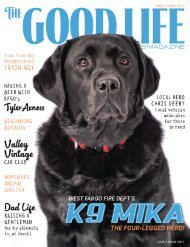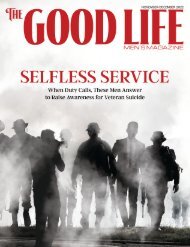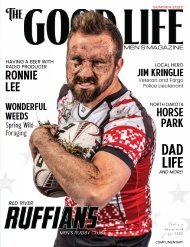The Good Life – September-October 2018
Featuring Barber Wil Dort. Local Hero - Patriot Assistance Dogs, Having a Beer with the founders of Drekker Brewing Company, Mr. Full-Time Dad and more in Fargo Moorhead's only men's magazine.
Featuring Barber Wil Dort. Local Hero - Patriot Assistance Dogs, Having a Beer with the founders of Drekker Brewing Company, Mr. Full-Time Dad and more in Fargo Moorhead's only men's magazine.
Create successful ePaper yourself
Turn your PDF publications into a flip-book with our unique Google optimized e-Paper software.
LOCAL HERO | PATRIOT ASSISTANCE DOGS<br />
A practical process<br />
For veterans seeking a service dog, the<br />
process starts with a basic application<br />
and an inquiry about the top three<br />
things a dog would need to do or help<br />
the person with. In order to comply<br />
with the American Disabilities Act,<br />
Wiedewitsch says the dog must be able<br />
to perform specific tasks to mitigate<br />
symptoms. For example, a dog can<br />
be trained to wake a veteran who<br />
experiences anxious dreams, she says.<br />
<strong>The</strong> dog is then trained to respond<br />
to its natural sensing of heart rate or<br />
respiration changes. Dogs can even<br />
sense adrenaline and blood pressure<br />
changes.<br />
“<strong>The</strong>y sense these changes before<br />
we as people are even aware they are<br />
happening,” Wiedewitsch says. <strong>The</strong>y<br />
can calm the veteran before a panic or<br />
anxiety attack actually occurs.<br />
Prior to acceptance, veterans have to<br />
provide information regarding their<br />
branch of service, dates of service<br />
and the terms of their separation from<br />
service, plus proof of treatment for<br />
mental health.<br />
“A dog is not the silver bullet,” she<br />
says. “A dog won’t cure everything.”<br />
That’s why the veteran has to supply<br />
34 / THE GOOD LIFE / urbantoadmedia.com<br />
information about mental health<br />
treatment, and the provider needs to<br />
detail the diagnosis and how a service<br />
dog would be a good component of the<br />
treatment.<br />
Veterans also need to supply<br />
information about a veterinarian<br />
that would treat the dog. “We’re very<br />
particular about the care of dogs,”<br />
she says. “We require that the dog be<br />
maintained at a healthy weight, be<br />
checked regularly, vaccinated properly.<br />
This is the dog’s second shot at a good<br />
life for them, and it’s our responsibility<br />
to make sure the veteran will provide<br />
that.”<br />
Finally, the veteran provides a sponsor,<br />
a friend or relative who will check<br />
in regularly on the person and the<br />
animal. A sponsor agrees to keep PAD<br />
informed if unusual circumstances<br />
arise.<br />
Once in, a veteran undergoes a weeklong<br />
training class to determine which<br />
dog is the best fit. Trainers may think<br />
they know which dog is right for a<br />
veteran, but often the dog identifies its<br />
own veteran.<br />
“We as trainers have to sit back because<br />
the dogs don’t get it wrong,” she says.<br />
Down to business<br />
Training dogs to serve humans is a<br />
serious business, and every dog has<br />
to pass the Canine <strong>Good</strong> Citizen test,<br />
the final check in a 10-step program<br />
developed by the American Kennel<br />
Club.<br />
<strong>The</strong> dog also has to demonstrate its<br />
ability to perform the three tasks that<br />
will help mitigate the symptoms the<br />
veteran experience. Both evaluations<br />
are conducted by someone outside of<br />
PAD.<br />
Once the team has trained, the veteran<br />
and dog return home and spend a<br />
minimum of six weeks and a maximum<br />
of six months living together and<br />
acclimating to the new life.<br />
“Basically, we’re looking for whether<br />
the dog does at home what we have<br />
trained it to do,” she says.<br />
If the dog does, the team returns to<br />
perform a public access and skills test<br />
conducted by a master dog trainer<br />
PAD hires to certify the dog. After that,<br />
the team is on a two-year probation to<br />
make sure the dog remains healthy, a<br />
check possible due to the veterinarian<br />
submitting records of annual<br />
checkups. Only after those two years<br />
and no infractions does the veteran<br />
take full ownership of the dog.<br />
A life spent serving<br />
PAD wants to serve veterans, and<br />
the demand for trained service dogs<br />
is high. When the organization was<br />
first founded, it accepted veterans<br />
nationwide. Soon after, PAD shrunk<br />
its service footprint to make sure it<br />
could adequately serve the teams it<br />
was matching and training.<br />
Applications roll in consistently, and if<br />
the wait for an available class exceeds<br />
12 months, the organization will<br />
suspend processing applications to<br />
make sure veterans don’t have to wait<br />
too long to receive a service dog.<br />
PAD is a lean organization, with no<br />
full-time employees and only four part-


















